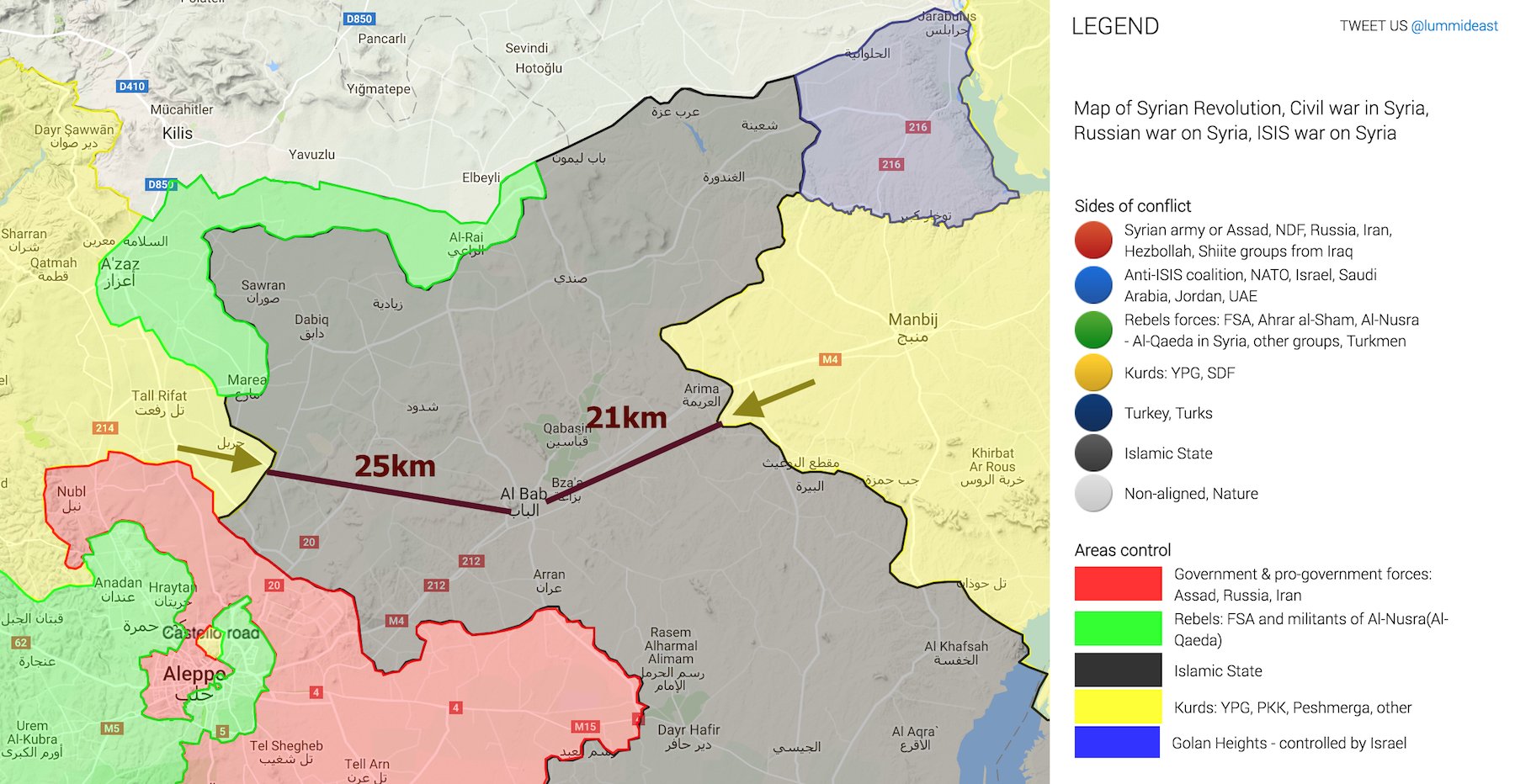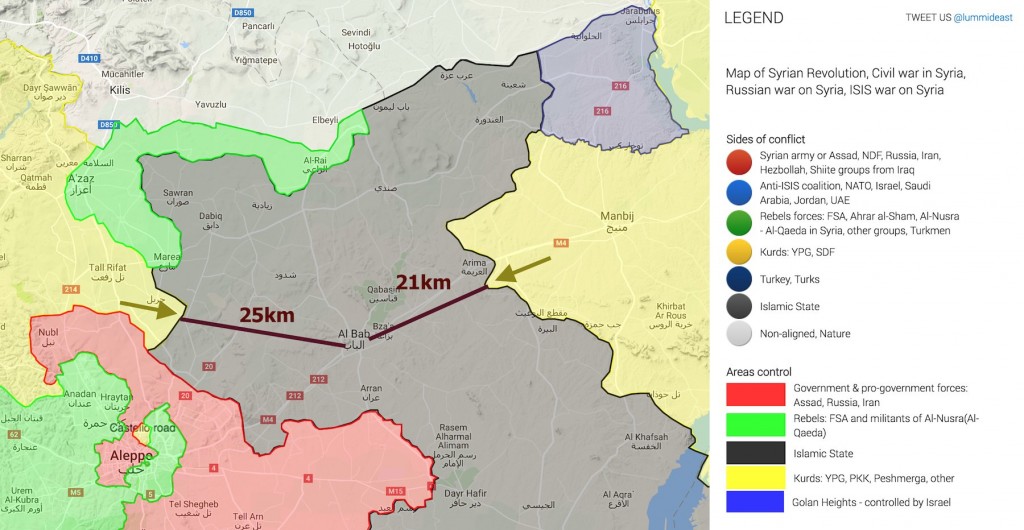It has been a week since the Turkish Armed Forces and thousands of troops of the allied factions of the rebel FSA crossed the Syrian borders close to the city of Jarablus.
Although the initial announcements of the Turkish Government noticed that the target of the military intervention of the 24th of August in Syria was the elimination of ISIS from northern Syria the military objectives of the “Euphrates Shield” operation proved to be different.
The same day, 24th of August, the Vice President of the USA Joe Binden asked from YPG the military branch of the Kurds in Syria, which is part of the Syrian Democratic Forces (SDF), to withdraw its forces from the west bank of the Euphrates River.
The Turkish Government expects to eliminate two of its enemies from this part of Syria, the ISIS and the SDF.
The SDF is an alliance of Kurdish, Arab, Assyrian, Armenian, Turkmen and Circassian militias fighting against the ISIS and against parts of the rebellion who cooperate with Army of Conquest, Fatah Halab and other Salafist and Islamist groups in northern Syria.
According to information, the initial invasion force included 5.000 troops of the allied factions of the rebel FSA, 25 M-60A3TTS main battle tanks, 20 ACV-15 Armored Infantry Fighting Vehicles of the 5th Tank Brigade and 350 Turkish troops.
Furthermore the Turkish Air Forced used 13 F-16C Block40TM fighter jets, one KC-135R military aerial refueling aircraft, one Ε-7Τ (B737AEW&C) and several Bayraktar TB2 UAV.
This military force was supported by several Turkish army Τ-155 Firtina self-propelled howitzers and T-122 Sakarya multiple rocket launchers.
During the first two days of the operation the Turkish tank detachment and the allied factions of the rebel FSA managed to gain the control of the border city of Jarablus and the countryside around the city.
On the 25th of August the YPG announced that it had had withdrawn to the east of Euphrates River and that it had handed over the military command to the Manbij Military Council and the local SDF military forces.
The rapid advance of the Turkish/FSA troops in northern Syria was helped by the absence of the ISIS troops from the region. ISIS had withdrawn its troops from Jarablus and the area close to the city one day before the Turkish military intervention.
The following days the Turkish/FSA troops advanced towards south following the route of Euphrates River. As Turkish President Tayyip Edogan said, his country wants SDF military forces withdrawn from the west side of the river Euphrates and redeploy to the east bank of the river.
This Turkish demand has been mentioned several times in the past, since Ankara wants to establish a buffer zone within Syrian territory between the Kurdish Canton of Efrin and the west bank of Euphrates River.
This buffer zone would be under the control of the Turkish allied factions of the rebel FSA, deterring any possible Kurdish attempt to unify the territories of the Efrin and Kobane Cantons.
On the other hand the Kurds are desperately trying to expand their territories at the Efrin Canton. The main target of the Kurds of Northern Syria and their allies is to break the isolation of the Erfin Canton located exactly next to Turkey, several kilometers from the Mediterranean coastline.
The 27th of August was the bloodiest day for the Turkish/FSA troops. Taking advantage of the withdrawn of ISIS from the region, SDF military forces advanced from their position north of the city of Manbij towards the city of Jarablus and achieved significant territorial gains.
The two armies met at the Amarinah-Maz’aalah-Yusuf Bayk line.
At that day, three Turkish M-60A3 TTS tanks were hit by SDF anti-tank missiles and one Turkish soldier was killed, while three more were injured.
One day earlier, the 26th of August, the Turkish Army sent to Syria ten more M-60A3 TTS tanks, raising the total number to 35 units, while the number of the Turkish troops involved to the operation raised to 400 men.
The advance of the Turkish/FSA troops towards the south continued on the 27th of August with the support of the Turkish Air Force. On the 27th of August Turkish aircraft bombed the positions of SDF at the Amarinah village forcing the defending forces of SDF to withdraw south
On the 28th of August, according to the Syrian Observatory for Human Rights at least 20 civilians were killed and 50 wounded in Turkish artillery fire and Turkish Air Force air strikes on the village of Jeb el-Kussa, and another 28 were killed and 25 wounded in Turkish air strikes near the town of Al-Amarneh and the village of Saressat.
The same day and the following day (the 29th of August), the Turkish/FSA troops made significant progress and capture the villages, Maz’alah, Ayn al Bayda, north and south Amarinah, Suraysat, Jubb al Kusa, Qirq Maghar, Zahr al Magharah, Qiratah, Awshariyah, Bal Maghar, Arab Hasan as Saghir, Mahsanli, Um Rusum, Malhamiya, Yaqoubiya, Halwanji.
On the 29th of August the river Sajur became the natural border between the SDF forces and the Turkish/FSA troops.
At the same day the 29th of August, the military forces of the Efrin Canton started an attack against the positions of ISIS, east of the Tall Rifat city. Within three days the SDF military forces from the Efrin Canton managed to advance several kilometers and captured the villages of Wahshiyah and Umm Al-Quraa. The main objective of this attack is the city of Al Bab, the capital of ISIS at the Shahba region.
The Kurds of the Efrin Canton know that If they do not establish a land corridor with the SDF controlled Manbij region, they will be the next target of FSA. The location of the Efrin Canton 46 kilometers from the nearest SDF controlled territories does not allow the Cantons of Kobani and Jazira to help Efrin in case of a FSA attack. Therefore the establishment of a land corridor with the SDF military forces of the Manbij city is crucial for the existence of the Efrin Canton.


